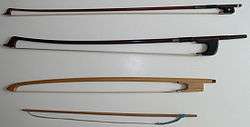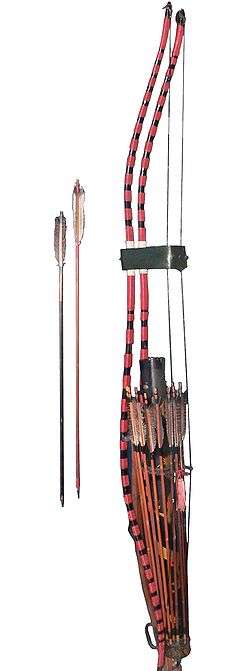Definify.com
Definition 2026
弓
弓
Translingual
| Stroke order | |||
|---|---|---|---|

| |||
Han character
弓 (radical 57 弓+0, 3 strokes, cangjie input 弓 (N), four-corner 17207)
- Kangxi radical #57, ⼸ (“bow”).
See also
Derived characters
References
- KangXi: page 356, character 1
- Dai Kanwa Jiten: character 9692
- Dae Jaweon: page 671, character 22
- Hanyu Da Zidian: volume 2, page 987, character 11
- Unihan data for U+5F13
Chinese
|
simp. and trad. |
弓 | |
|---|---|---|
Glyph origin
| Historical forms of the character 弓
| ||||
|---|---|---|---|---|
| Oracle bone script | Bronze inscriptions | Bamboo and silk script | Large seal script | Small seal script |
 |
 |
 |
 |
 |
| Characters in the same phonetic series (弓) (Zhengzhang, 2003) | |
|---|---|
| Old Chinese | |
| 弓 | *kʷɯŋ |
| 穹 | *kʰʷɯŋ |
| 焪 | *kʰʷɯŋ, *kʰʷɯŋs |
| 芎 | *kʰʷɯŋ |
Pictogram (象形) - pictographic representation of a bow.
Pronunciation
- Mandarin
- (Standard Chinese, Beijing)+
- Pinyin:
- Zhuyin: ㄍㄨㄥ
- Wade-Giles: kung1
- Gwoyeu Romatzyh: gong
- IPA (key): /kʊŋ⁵⁵/
- (Standard Chinese, Beijing)+
- Cantonese
- (Standard Cantonese, Guangzhou)+
- Jyutping: gung1
- Yale: gūng
- Cantonese Pinyin: gung1
- IPA (key): /kʊŋ⁵⁵/
- (Standard Cantonese, Guangzhou)+
- Hakka
- (Sixian, incl. Miaoli and Meinong)
- Pha̍k-fa-sṳ: kiung
- Hakka Romanization System: giung
- Hagfa Pinyim: giung4
- IPA: /ki̯uŋ⁵⁵/
- (Sixian, incl. Miaoli and Meinong)
- Min Nan
- (Hokkien)
- Pe̍h-ōe-jī: keng / kiong
- Tâi-lô: king / kiong
- Phofsit Daibuun: kefng, kiofng
- IPA (Xiamen): /kiɪŋ⁴⁴/, /kiɔŋ⁴⁴/
- IPA (Quanzhou): /kiɪŋ³³/, /kiɔŋ³³/
- IPA (Zhangzhou): /kiɪŋ⁴⁴/, /kiɔŋ⁴⁴/
- IPA (Taipei): /kiɪŋ⁴⁴/, /kiɔŋ⁴⁴/
- IPA (Kaohsiung): /kiɪŋ⁴⁴/, /kiɔŋ⁴⁴/
- Note: keng - vernacular, kiong - literary.
- (Teochew)
- Peng'im: gêng1
- Pe̍h-ōe-jī-like: keng
- IPA (key): /keŋ³³/
- (Hokkien)
- Wu
- (Shanghainese)
- Wiktionary: kon (T1)
- IPA (key): /kʊŋ⁵³/
- (Shanghainese)
- Dialectal data▼
| Variety | Location | 弓 |
|---|---|---|
| Mandarin | Beijing | /kuŋ⁵⁵/ |
| Harbin | /kuŋ⁴⁴/ | |
| Tianjin | /kuŋ²¹/ | |
| Jinan | /kuŋ²¹³/ | |
| Qingdao | /kəŋ²¹³/ | |
| Zhengzhou | /kuŋ²⁴/ | |
| Xi'an | /kuŋ²¹/ | |
| Xining | /kuə̃⁴⁴/ | |
| Yinchuan | /kuŋ⁴⁴/ | |
| Lanzhou | /kũn³¹/ | |
| Ürümqi | /kuŋ⁴⁴/ | |
| Wuhan | /koŋ⁵⁵/ | |
| Chengdu |
/koŋ⁵⁵/ /t͡ɕyoŋ⁵⁵/ |
|
| Guiyang |
/koŋ⁵⁵/ /t͡ɕioŋ⁵⁵/ |
|
| Kunming | /koŋ/ | |
| Nanjing | /koŋ³¹/ | |
| Hefei | /kəŋ²¹/ | |
| Jin | Taiyuan | /kuəŋ¹¹/ |
| Pingyao | /kuŋ¹³/ | |
| Hohhot | /kũŋ³¹/ | |
| Wu | Shanghai | /koŋ⁵³/ |
| Suzhou | /koŋ⁵⁵/ | |
| Hangzhou | /koŋ³³/ | |
| Wenzhou | /t͡ɕoŋ³³/ | |
| Hui | Shexian | /kuʌ̃³¹/ |
| Tunxi | /kan¹¹/ | |
| Xiang | Changsha | /koŋ³³/ |
| Xiangtan | /kən³³/ | |
| Gan | Nanchang | /kuŋ⁴²/ |
| Hakka | Meixian | /kiuŋ⁴⁴/ |
| Taoyuan | /kioŋ²⁴/ | |
| Cantonese | Guangzhou | /koŋ⁵³/ |
| Nanning | /kuŋ⁵⁵/ | |
| Hong Kong | /kuŋ⁵⁵/ | |
| Min | Xiamen (Min Nan) |
/kiɔŋ⁵⁵/ /kiŋ⁵⁵/ |
| Fuzhou (Min Dong) | /kyŋ⁴⁴/ | |
| Jian'ou (Min Bei) | /kœyŋ⁵⁴/ | |
| Shantou (Min Nan) | /keŋ³³/ | |
| Haikou (Min Nan) |
/koŋ²³/ /kiaŋ²³/ |
| Rime | |
|---|---|
| Character | 弓 |
| Reading # | 1/1 |
| Initial (聲) | 見 (28) |
| Final (韻) | 東 (2) |
| Tone (調) | Level (Ø) |
| Openness (開合) | Open |
| Division (等) | III |
| Fanqie | 居戎切 |
| Reconstructions | |
| Zhengzhang Shangfang |
/kɨuŋ/ |
| Pan Wuyun |
/kiuŋ/ |
| Shao Rongfen |
/kiuŋ/ |
| Edwin Pulleyblank |
/kuwŋ/ |
| Li Rong |
/kiuŋ/ |
| Wang Li |
/kĭuŋ/ |
| Bernard Karlgren |
/ki̯uŋ/ |
| Expected Mandarin Reflex |
jiōng |
| Baxter-Sagart system 1.1 (2014) | |
|---|---|
| Character | 弓 |
| Reading # | 1/1 |
| Modern Beijing (Pinyin) |
gōng |
| Middle Chinese |
‹ kjuwng › |
| Old Chinese |
/*kʷəŋ/ |
| English | bow (n.) |
Notes for Old Chinese notations in the Baxter-Sagart system: * Parentheses "()" indicate uncertain presence; | |
| Zhengzhang system (2003) | |
|---|---|
| Character | 弓 |
| Reading # | 1/1 |
| No. | 4079 |
| Phonetic component |
弓 |
| Rime group |
蒸 |
| Rime subdivision |
0 |
| Corresponding MC rime |
弓 |
| Old Chinese |
/*kʷɯŋ/ |
Definitions
弓
Compounds
Japanese
Kanji
Readings
- Goon: く (ku) (non-Jōyō reading), くう (kū) (non-Jōyō reading)
- Kan’on: きゅう (kyū)
- Kun: たらし (tarashi), ゆ (yu), ゆみ (yumi)
- Nanori: こ (ko), ゆ (yu)
Etymology 1
| Kanji in this term |
|---|
| 弓 |
|
ゆ Grade: 2 |
| kun'yomi |
From Old Japanese. In modern Japanese, only found as a prefix in compounds.[1][2]
Pronunciation
Prefix
弓 (hiragana ゆ, romaji yu-)
Derived terms
Etymology 2


| Kanji in this term |
|---|
| 弓 |
|
ゆみ Grade: 2 |
| kun'yomi |
Appears to be Old Japanese yu + suffixing element mi, itself of uncertain derivation.
Pronunciation
Noun
- a bow:
- (weaponry) a bow for shooting arrows
- (music) a bow for playing a stringed instrument such as a violin or cello
- archery
- (Shintō) a type of kagura (sacred Shinto song and dance) intended to drive away evil
- short for 破魔弓 (hama yumi): a ceremonial archery bow with the power to dispel evil
- a bow shape, a curve
- a bow-shaped tool used to beat ginned cotton into a softer and finer textile
Coordinate terms
Derived terms
|
See also
- ロングボウ
External links
-
 弓_(武器) on the Japanese Wikipedia.Wikipedia ja (archery)
弓_(武器) on the Japanese Wikipedia.Wikipedia ja (archery) -
 Yumi (Japanese archery bow) on Wikipedia.Wikipedia
Yumi (Japanese archery bow) on Wikipedia.Wikipedia
-
 弓_(楽器) on the Japanese Wikipedia.Wikipedia ja (music)
弓_(楽器) on the Japanese Wikipedia.Wikipedia ja (music) -
 Bow_(music) on Wikipedia.Wikipedia
Bow_(music) on Wikipedia.Wikipedia
Etymology 3
| Kanji in this term |
|---|
| 弓 |
|
たらし Grade: 2 |
| kun'yomi |
Alteration from torashi, 連用形 (ren'yōkei, “stem or continuative form”) of verb torasu, from tora as the 未然形 (mizenkei, “incomplete form”) of verb 取る (toru, “to take”) + す (su, honorific suffix in Old Japanese). Original meaning was “something kept to hand”.[1][2]
Pronunciation
Alternative forms
Noun
弓 (hiragana たらし, romaji tarashi)
Synonyms
- 御執, 御弓 (みたらし, mitarashi)
Etymology 4
| Kanji in this term |
|---|
| 弓 |
|
きゅう Grade: 2 |
| on'yomi |
From Middle Chinese 弓 (*giung).[1][2] Compare modern Mandarin 弓 (gōng).
Pronunciation
Noun
- (rare) a bow
- (obsolete) in ancient Chinese archery, a unit of length for measuring the distance between the archer and the target; one kyū was equal to six 尺 (shaku), roughly six feet or 182 centimeters
- (obsolete) in ancient China, a unit of length for surveying land; one kyū was equal to eight 尺 (shaku), roughly eight feet or 242 centimeters
Usage notes
In modern Japanese, the reading kyū is most often found in compounds.
Derived terms
References
- 1 2 3 1988, 国語大辞典(新装版) (Kokugo Dai Jiten, Revised Edition) (in Japanese), Tōkyō: Shogakukan
- 1 2 3 4 5 2006, 大辞林 (Daijirin), Third Edition (in Japanese), Tōkyō: Sanseidō, ISBN 4-385-13905-9
- ↑ 1998, NHK日本語発音アクセント辞典 (NHK Japanese Pronunciation Accent Dictionary) (in Japanese), Tōkyō: NHK, ISBN 978-4-14-011112-3
